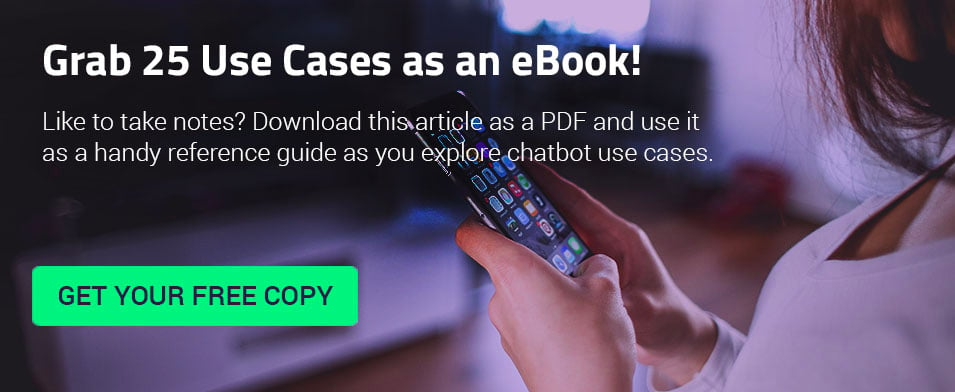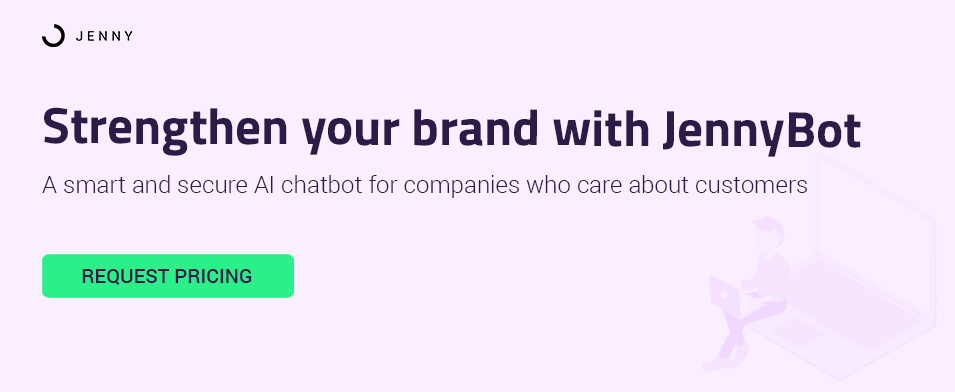by Mikko Rindell
on September 04, 2019
Chatbot Use Cases: 25 real-life examples
There are many ways to upgrade communication between your company and its customers. One effective method (both in terms of cost and results) for any business to improve their customer service game is by using chatbots. Recently, chatbots have been applied in many different aspects of business and have had many proven records of success.
In this article, we will share with you 25 real-life chatbot use cases in the fields of Customer Service, Marketing and Sales. We will analyze how these companies are successfully using chatbots to engage their customers in order to boost their business growth. But first, let’s walk through a few basic points about chatbots.
Generally speaking, a bot is a piece of software designed to perform an automated task. And a chatbot is supposed to conduct a conversation with a human using textual or auditory methods. Chatbots simulate how a human would behave as a conversational partner and thus can answer questions and carry the conversation.
Table of Content
- Why A Chatbot Dramatically Improves Customer Support
- Two Types of Chatbots To Know About
- Chatbot Use Cases in Customer Service
- Chatbot Use Cases in Marketing
- Chatbot Use Cases in Sales
Why A Chatbot Dramatically Improves Customer Support
There are two important reasons to make a chatbot an effective customer service agent for your business:
1. Customers Prefer Texting: The primary means of communication with a chatbot is via text. And customers prefer this method. Moreover, The State of Global Customer Service Report 2018 shows that 66% of customers try to use self-service first. And one of the most effective self-service customer support tools that uses texting is a chatbot. 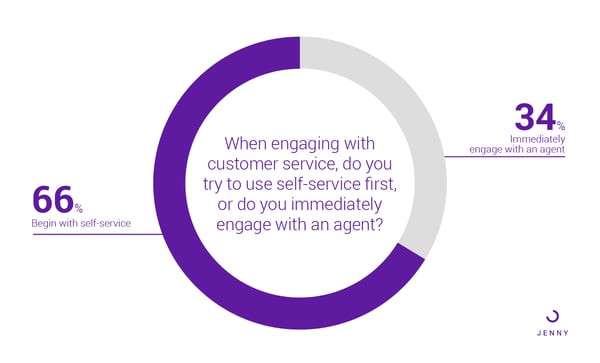
2. Chatbot is Instant & 24/7: A chatbot, unlike a customer support agent, never takes breaks, sleeps or goes offline. With chatbots, businesses can provide 24/7 customer support. And that’s exactly what customers want: instant customer support that’s available at all times. The Live Chat Benchmark Report 2019 proves this. According to this report, live chat has a higher customer satisfaction rating than other customer support channels due to its speed and conversational nature.
Two Types of Chatbots To Know About
There are two primary kinds of chatbots a business can use:
- Transactional Chatbot
- Conversational Chatbot
A transactional chatbot is pre-designed to provide a customer with a fixed set of choices. A customer can select an option that is relevant to what they want to do or what problem they want to solve. Once a customer selects a choice, the chatbot will guide them through the whole process by providing more options to the customer until their question has been answered or until their problem has been solved.
This kind of chatbot is excellent for businesses such as restaurants, online delivery services, and banks who know in advance what common solutions a customer may require.
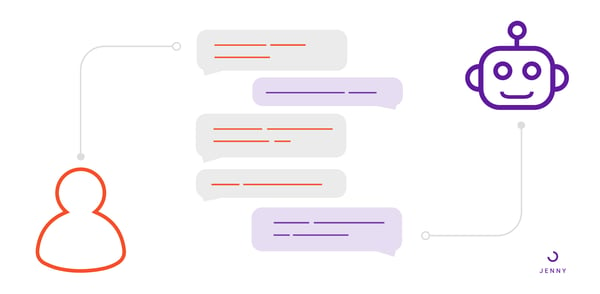
A conversational chatbot, on the other hand, is designed to understand and respond to a conversation in a natural, human-like manner. To be able to do this, the chatbot is equipped with artificial intelligence and access to knowledge databases and other information so it can become ‘contextually aware’. Once it is contextually aware, it can pick up variations in a customers question/query/response and give relevant answers in a more human-like way.
This kind of chatbot is used by businesses with advanced SaaS tools, as well as B2B companies providing enterprise solutions and online social platforms.
25 Awesome Chatbot Use Cases
How can chatbots benefit your business? We’ve compiled a list of amazing chatbot use cases from different industries. We’ll show you how companies of all shapes and sizes are using chatbots for various tasks in the fields of Customer Service, Marketing and Sales.
Chatbot Use Cases in Customer Service
1. Chatbots Answer Questions And Inquiries
Say a company holds an event. Prior to the event, they hype it up by marketing, in hopes of attracting as big an audience as possible. Now, it’s up to the customer support team to guide the audience and answer any questions that come up.
If the audience is small—say 20 to 50 people— this is not a difficult task. But what if 1000 people are coming to the company’s event? Or 5000? Or even 10,000? What then?
In this case, providing high-quality support and guidance is not an easy job. Here, a chatbot, thanks to its 24/7 presence and ability to reply instantly, can be of immense help.
The company organizing the event can set up the chatbot to answer common questions like:
- What does the ticket cost? And where do I buy it?
- How do I get to the venue?
- Who will be speaking at the event?
- What’s the schedule of the event?
- Are there any hotels nearby?
Once the chatbot is set up, the company can add it to their event’s webpage and/or app then let it interact with customers.
Slush, an organization that holds entrepreneurial events all over the world, did exactly this and experienced very positive results. The Jenny chatbot by GetJenny on Slush’s website successfully handled 64% of all customer support requests for the Slush customer support team—a significant load. And if that wasn’t enough, because of the 24/7 availability of the Jenny chatbot on Slush’s website and mobile app, people started 55% more conversations with Slush than the previous year.
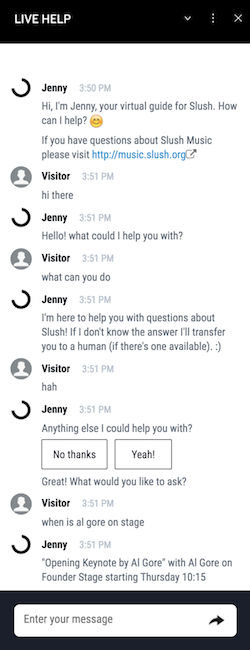
Jenny the bot communicates with Slush website visitors in a human-like manner.
The Jenny chatbot handled questions from approximately 20,000 attendees. To learn more about this successful integration worked, download this case study about how GetJenny helped Slush boost their customer support using a chatbot.
So it doesn’t matter what size a company’s audience or user base is. If they are organizing a big event or have a big product that generates a lot of customer support requests, a chatbot is an effective tool that can significantly reduce the customer support team’s workload, thereby enabling them to provide high-quality support to the company’s target audience.
2. Book Tickets To Events/Shows With Chatbots
Before making a purchasing decision, most customers will ask the same types of questions regarding what they are buying. Answering such repetitive questions will take up your customer support’s valuable time and resources.
A better solution would be to deploy a chatbot on your website and design it to answer basic questions your salespeople get regularly. These can be questions like:
- Which movies are playing today?
- Can I get a refund for my ticket?
- Which seats are available?
By answering such questions, a chatbot can guide a customer and solve their problem for them. But that’s not all. A chatbot can also help the customer take the action they want.
For example, PVR Cinemas own one of the largest chains of movie theatres in India. And on their website, you’ll find a chatbot that helps visitors quickly book movie tickets, view offers, and leave feedback.
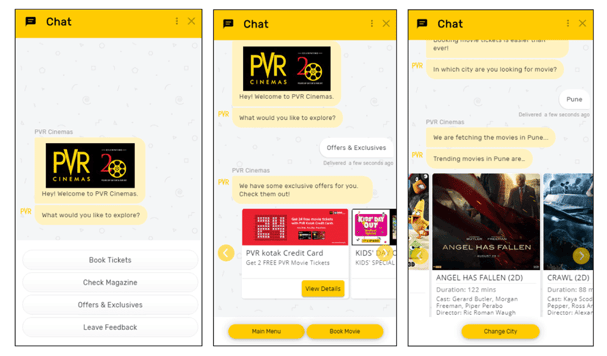 A chatbot is helping customers choose the movie to watch.
A chatbot is helping customers choose the movie to watch.
The chatbot also lets visitors view the trailer for the movie they want to watch - which helps them make a buying decision. This means the chatbot, in addition to providing support, also helps increase sales.
This application of chatbot isn’t just limited to movie theatres. Performers, sports teams, organizations, nonprofits, and anyone creating an event can use chatbots to smoothly sell tickets to their fans and audiences.
3. Use Chatbots To Find Products, Check Inventory and Recommend Items
Sometimes, the only thing standing between you and a sale is a customer’s inability to perform a simple action themselves in order to find what they want and make a buying decision.
In this case, customers simply look for an easy way to contact a customer support agent to help them solve their ‘problem.’ This can be something as easy as asking for a recommendation or something more complex like checking inventory for a particular item.
For a customer support agent, these are cumbersome tasks. Checking for inventory is something a customer can do by searching for and visiting a particular product page. And as for making recommendations, support agents know that coming up with suggestions can take up a lot of time.
A solution to help free up customer service agents’ time would be to get a chatbot to handle these sorts of questions. Here’s why:
- Chatbots are fast at searching through data: A customer support agent will have to manually check if a product is in the inventory. A chatbot, thanks to its ability to look through your website’s database, can provide an instant answer.
- Chatbots can make personalized recommendations: You can set up your chatbot to make recommendations and ask questions to your customers. Based on the replies a customer gives, the chatbot can make relevant suggestions regarding what the customer should buy.
Again, all this will free up your customer support agents’ time, which they can use to solve the more serious problems of customers who need to interact with a human within your company.
E-commerce websites, like those for clothing stores, food delivery, or flower delivery services, can use chatbots for this task, especially because their customers often ask for recommendations and check the area of that item in stock before ordering.
4. Chatbots To Build Remarkable Customer Experience
Chatbots don’t have to be serious and purely transactional. You can design them to go through a buying decision by creating a ‘quiz’, telling jokes along the way, and sending the occasional meme.
In addition, chatbots are very effective at giving instruction. For example, they can quickly show pictures of products, give clickable options, provide live links to Google Maps directions and more.
This makes a chatbot a really useful technology that customers will have fun interacting with. And any positive experience a customer has using your chatbot will go a long way to elevating your company’s brand image.
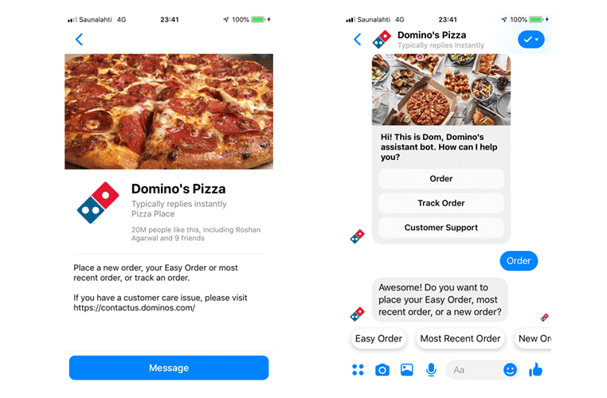
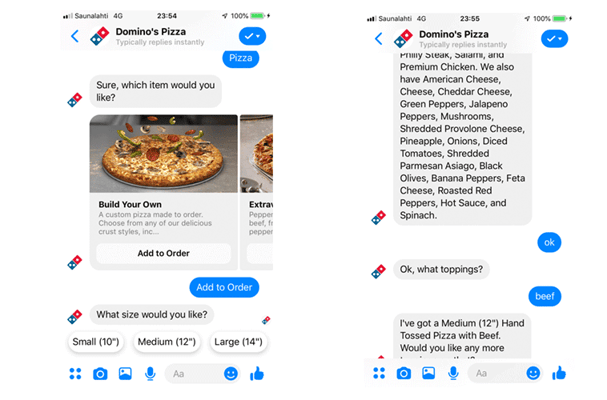
Chatbots can interact with customers through images, videos or gifs and build a remarkable customer experience.
Here, Dominos applies a chatbot efficiently to make the ordering process run more smoothly between customers and restaurants. Besides providing engaging and straightforward communication, another benefit here is convenience. The customers don’t have to download an extra app to their phone, dial the phone numbers, or open a website to order their pizza. All the customers do is joining a conversation with the bot in Messenger!
5. Chatbots Can Process Return and Exchange Requests
One of the most common requests customer support agents get from customers is for refunds and exchanges. Companies often have a clear policy in place for processing such requests. This means, for customer support agents, performing most refunds and exchanges is a repetitive and monotonous task.
As such, a chatbot, if designed to carry out the company’s refund and exchange policy, can certainly execute these tasks instead of customer support agents in your company.
In fact, you can ‘bake’ this function right into the chatbot’s chat window with an option clearly labeled ‘get a free refund’. And of course, in the same way, a chatbot can make a refund, it can also process item exchanges as well.
6. Chatbots Can Confirm Orders And Track Shipping
After buying a product, customers may want to know how much time remains until their product ships.
Usually, there is a complicated process in place to do that. Customers have to go through their email to find the shipping number of the product they bought, then go to the company’s website from where they bought the product. Then they have to go to the delivery service’s website to enter the shipping number.
No wonder many customers prefer asking a customer support agent to provide their product’s shipping status.
A better solution overall would be to employ a chatbot. Customers can simply enter their product’s shipping ID there and get a status update.
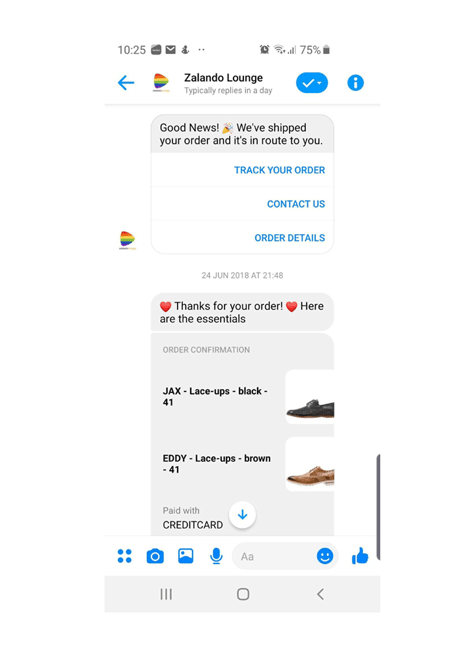 Chatbots can provide information on orders and shipping.
Chatbots can provide information on orders and shipping.
Zalando, a European popular fashion brand, uses this feature in its chatbot use cases to provide instant order tracking for its customers - right after they have made a purchase. This frees their customer support team to cater to those customers who need support for more complex problems.
7. Chatbots Help You Collect Customer Feedback Efficiently
Every successful business has one thing in common: They deliver outstanding customer service for their great products that customers actually want. And the way they do that is by using customer feedback. Because no matter the number of intelligent people your company has, no one can tell you how to improve more than an actual customer.
But how do you collect customer feedback from a wide-ranging set of customers? Every company that tries to do surveys experiences one thing: it’s tough getting customers to participate in your surveys.
The number one reason for this is the friction on customers face when a company asks them to take part in a survey. You see, most of the time, the customer has to click on a link (usually through emails) to go to a new webpage, fill out a lengthy form, and type in answers. But this is not an effective way to conduct surveys.
In fact, various studies have shown that traditional surveys over emails have a 10% open rate with less than 5% completion rate in the best of cases.
Plus, it doesn’t matter how much a business ‘requests’ a customer to take part in your survey. If doing that requires a lot of effort, they simply won’t. Unless the company is a brand that customers are very much loyal to.
Here’s what companies must remember: Surveys are only for the benefit of the business, not the customer.
That’s why it is the company’s job to make it easier for customers to provide feedback. Fred Reichheld, who invented the NPS (Net Promoter Score) made a similar comment: “The instant we have the technology to minimize surveys, I’m the first one on that bandwagon.”
An effective technology that can do exactly this is chatbots.
Research (2019) suggests that 34% of customers feel frustrated when they cannot get answers to simple support queries—and surveys are exactly that—but with the company on the asking end instead of the customer. Plus, a chatbot can be accessed quickly with the press of a button.
Also, chatbots generate a high level of engagement thanks to their conversational nature, which leads to more people completing more surveys, thus creating a win-win situation for both companies and customers.
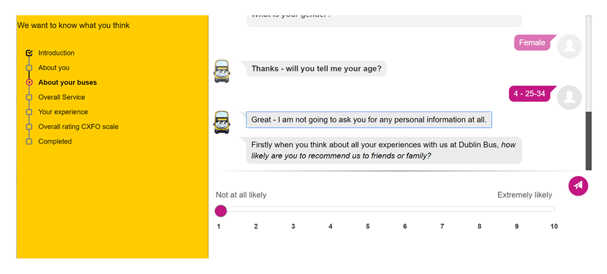 Chatbots are widely used to collect customer feedback and run surveys.
Chatbots are widely used to collect customer feedback and run surveys.
In the above screenshot, you can see a demonstration of how a survey chatbot works. The company’s chatbot asks the customer if they would like to participate in the survey. Once the customer agrees, the survey instantly starts. The customers don’t even have to type in anything. They can simply choose from the ‘options’ provided under the question to move through the survey. Plus, the use of images, GIFs, and videos above the questions makes the survey less boring.
All this contributes to making customers more engaged with surveys, all thanks to the way chatbots present them.
8. Chatbots Assign Customer Requests To Support Teams
Yes, a chatbot is very effective for dealing with customers who come forward with simple requests and frequently asked questions. But sometimes, customers face more complex problems that require human interaction.
Generally, the customer has to email the customer support department and wait for a reply. Or they have to call the company’s support line and move from one agent to another. All this involves the customer having to do a lot of steps and possibly wait a long time.
But with chatbots, there is no waiting around and no friction.
A customer can simply request the chatbot connect them to a human customer support agent and, in an instant, they could be talking to an agent immediately.—no waiting around and no changing communication channels. On the customer support end, chatbots can automatically create customer support tickets for the customer requesting live support and assign that tickets to the appropriate agent.
For example, here's HOAS (The Foundation for Student Housing in the Helsinki Region) virtual assistant Helmi. The chatbot is available on the page 24/7 and independently handles over 59% of customer queries. But if a customer question is more complicated or a customer wants to speak directly to a live chat agent, Helmi the chatbot checks whether any customer service agent is available at the moment and redirects the client to him/her.
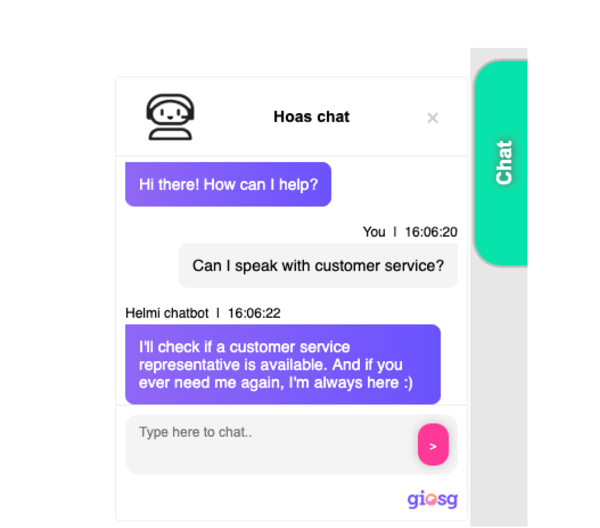 Chatbots can help customers solve the issue, or to connect a client with an available agent.
Chatbots can help customers solve the issue, or to connect a client with an available agent.
By the way, HOAS customer service chatbot is a great example of how a bot can increase customer satisfaction score and help to build a stronger brand. Download HOAS chatbot project case study to learn more about how HOAS implemented and developed its chatbot.
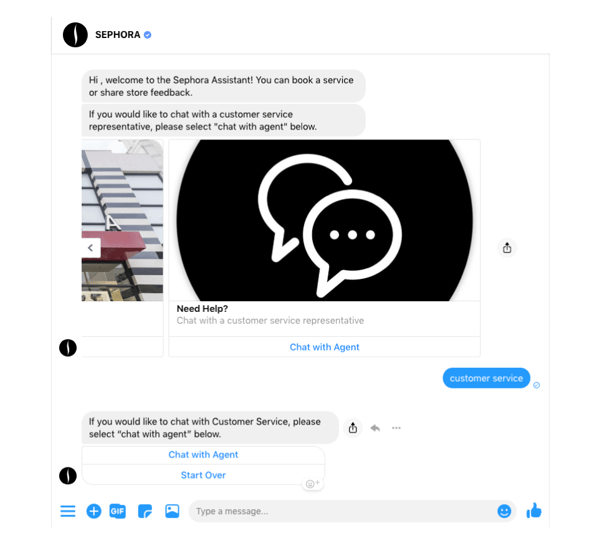 Sephora bot redirects conversations to a live agent, when needed.
Sephora bot redirects conversations to a live agent, when needed.
Here’s another example of cosmetics giant Sephora using a chatbot to provide one-click customer service. Providing this feature is necessary because Sephora’s customers may sometimes have special demands that a chatbot can’t process on its own. To communicate that, the customer only has to enter their email (or other information) and that store’s customer support team will reach out to them automatically.
Chatbot Use Cases in Marketing
9. Chatbots Generate Leads With Sales Approach
Many companies today invest a lot in sales teams to find and convert leads. Their goal is to contact cold prospects and get them interested in the company’s products and services.
Today, another effective approach for a company is to focus on the audience that’s already interested in its products, i.e., website visitors. Sales teams often refer to these audience members as ‘warm leads.’ Warm leads are the people who have actually engaged with the company’s website and are much more likely to answer sales questions. Often times, they are looking to purchase products but need time and/or assistance to finish the transaction.
To get in touch with warm leads, a live sales team won’t do. That’s because your traffic is anonymous and there is no way for a company to identify and contact visitors who visited their website.
Instead, a better option would be to add a chatbot to your website’s homepage. This chatbot can be designed to ask sales-oriented questions to your audience and guide them to and through the checkout process.
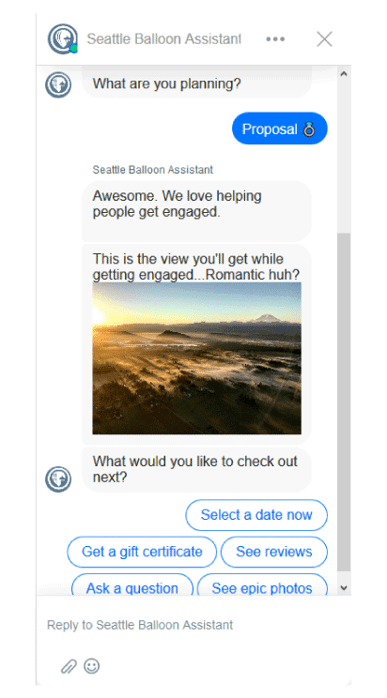 Chatbot is an effective tool for interacting with warm leads. Just like your sales team does.
Chatbot is an effective tool for interacting with warm leads. Just like your sales team does.
Seattle Ballooning, a company that offers hot-air balloon rides, perfectly executed this strategy with their Seattle Ballooning Assistant. You can see how they ask relevant questions and offer options to select the problem the customer is facing. By using the answers the customers give the chatbot, they can build customer profiles as well.
This means that Seattle Ballooning can provide personalized services throughout the purchase process. In this way, Seattle Ballooning markets in the most effective way—to their most receptive audience already looking for purchase guidance.
10. Chatbots In A Second-Net Strategy
For lead generation, the primary method customers offer companies is a lead generation form. While this is a good option, the chance of converting your customers with a lead generation form is between 2.5% to 5%. While this is a respectable conversion rate, businesses should also apply the ‘second net’ strategy, which is effective for those website visitors who do not convert with landing pages and forms.
Here’s what the second-net strategy entails:
For those website visitors who do not prefer submitting lead generation forms, a business can add a chatbot to their website/app and engage customers there. The chatbot can ask relevant questions, which would lead to a more engaging way for customers to submit their contact information.
A chatbot also serves as an excellent lead generation tool on its own. Businesses that do not want to use a form can deploy a chatbot on their website and engage customers with rich conversations. Vainu, a data analytics service, does exactly that with their VainuBot. On their website, the VainuBot asks questions to visitors. Visitors can quickly make choices by simply selecting the option most relevant to them.
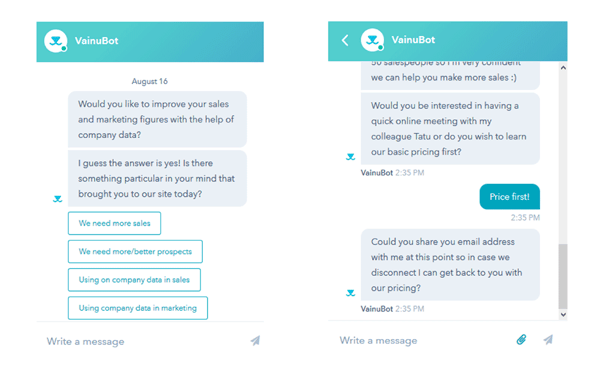 The second-net strategy is proved to be an effective way to generate more leads.
The second-net strategy is proved to be an effective way to generate more leads.
By the end, when the chatbot asks for their email address to book a demo or send a report, the visitor who took part in the chatbot quiz is much more likely to submit their email address.
Companies who want to collect more information about their leads can use this chatbot use case as well. All they have to do is pre-design a chatbot to ask multiple-choice questions and respond with new questions based on the previous answers given by visitors.
By employing such a system, companies will see more leads generated compared to a simple lead generation form.
11. Chatbots Help You Build Email Lists More Effectively
If companies want to collect emails of customers, prospects and even visitors, they usually have no choice but to use a form of some kind. It can either be a full-page pop-up form or a small in-the-corner barely visible form. While these do get conversions, most people simply close the form or ignore it. This is because forms are perceived as a kind of ad by many and feel it ruins the experience of a website.
Chatbots provide a less-annoying, more engaging way of collecting leads. Unlike forms, which simply demand email addresses in exchange for a lead magnet, a chatbot tries to start a thoughtful conversation asking the visitor what they would like to do.
Hiver, a service that provides shared-email services to companies, does this job beautifully.
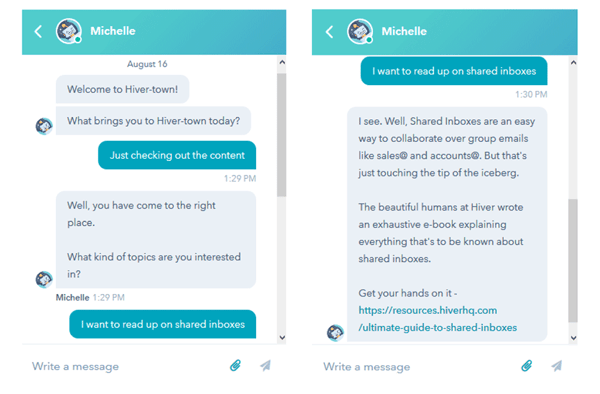 Chatbot is a very convenient way for people to find downloadables on a website. And a very good way for companies to generate leads.
Chatbot is a very convenient way for people to find downloadables on a website. And a very good way for companies to generate leads.
Using their chatbot, they first ask their visitors what they would like to do. If someone selects the option ‘just checking out the content’, it asks what topics you’re interested in. Then based on the selection, it presents a link to a case-study the visitor can get if they want.
This boosts conversations much more than forms as the visitor is also engaged in the conversation and getting an appropriate response to their questions. This dramatically increases the chances that the visitor will submit their email in exchange for the case-study, all because a chatbot facilitates meaningful conversations.
12. Chatbots Help Simplify Pricing
When visitors go to a company’s pricing page to buy their products and services, they might get confused with the sheer variety of options available to them, even though the company might have placed comparison charts outlining the different features available in different tiers.
If prospects are left confused with your pricing, they might decide not to go through with the purchase. Also, customers may not want to admit to the customer service department that they are having problems understanding the pricing plan.
To avoid putting customers in this tight spot, companies can deploy a chatbot on their website’s pricing page, where it can gently let visitors know that if they want help deciding which service/product they should get, they can ask the chatbot.
AmTrak, a railroad service in U.S.A and Canada, has used this chatbot use case.
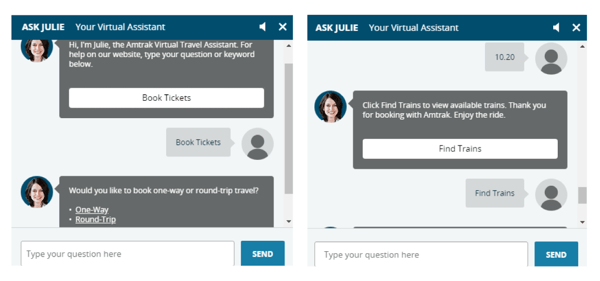 This chatbot helps clients to find the most suitable road and book train tickets.
This chatbot helps clients to find the most suitable road and book train tickets.
Amtrak deployed a chatbot called Julie on their website to help customers find the shortest routes to their favorite destinations. By assisting customers in booking tickets with Julie chatbot, according to one study, Amtrak has increased their booking rate by 25% and saw a 50% rise in user engagement and customer service. Julie answers on an average of 5 million questions per year.
Any company wishing to simplify its product/service pricing can employ the chatbot use case for this very purpose on their pricing page as well.
13. Chatbots Promote Products With Fun Conversations
Companies need to employ different marketing strategies for different audiences. For example, one audience might be interested in thoughtful conversations about your product/service. But another audience might be more interested in fun quizzes. As such, the marketing channel you use to attract customers must adapt to the audience’s needs and requirements.
Chatbots do exactly that.
As we said above, people love to engage in conversations instead of filling out forms. More than that, people love entertaining quizzes. But what people love the most is quizzes that offer goodies at the end. If a company can create such a reward system, it will generate more leads.
And chatbots provide the easiest way to do that.
With chatbots, you can use memes, GIFs, images, emojis, and other fun content to spice up your product recommendation system. American Eagle Outfitters uses this chatbot use case to great effect.
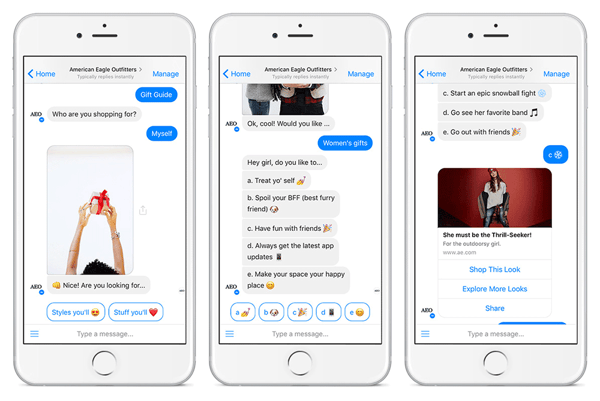 Chatbots can promote products and services in a human-like manner.
Chatbots can promote products and services in a human-like manner.
With their chatbot, American Eagle Outfitters start casual conversations with their audience. Based on customer answers, the chatbot recommends products and services. Along the way, they employ memes, pop references, and other content to keep their audience’s interest, which in their chatbot use case, consists primarily of females age 13 and above.
With this, we can see that any company wanting to engage in a radically different manner with their customers can use chatbots.
14. Chatbot Helps You Improve your Funnel Marketing
Most businesses cannot ask a first-time visitor to buy their products and services. Doing so will alienate visitors by leaving the impression that the business is desperate, which can be a big turnoff.
Instead, what a business should do is make a visitor feel welcome on their website, listen to their needs and requirements, and ask them if they’d be interested in a piece of useful content, such as an ebook, an email course, or a demo.
Interacting with visitors in such a way is more likely to establish trust. Plus, once they give their email in exchange for useful content, the business can send them additional marketing emails that provide valuable content. Over time as these email subscribers receive marketing emails, many will actually buy the business’ products and services.
To make visitors feel welcome on websites, businesses can employ a chatbot.
This chatbot by Vainu can answer visitor questions, familiarize them with available products and services, and eventually get their email address. And because the chatbot is conversational and can engage visitors 24/7 automatically, this website can generate leads around the clock.
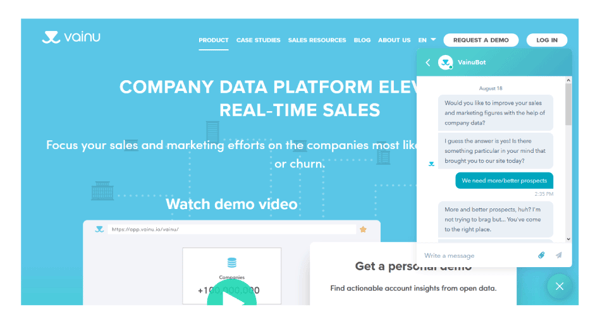 Chatbot can become an essential phase of your marketing funnel...
Chatbot can become an essential phase of your marketing funnel...
On the Vainu website, the chatbot asks incoming visitors the question “Would you like to improve your sales and marketing figures with the help of company data?”. For most visitors, the answer to that is “yes.” When they open the chat window, they see additional questions they can answer with a simple click or touch.
 ... helping to get even more leads!
... helping to get even more leads!
As the conversation continues, the visitor gets a genuine request for their email. If they are interested in the business’ services, the visitor will give their email to the chatbot, which will then be added to the business’ mailing list.
15. Chatbots Can Do Quizzes, Promotions, And Contests With Customers
Businesses who are willing to invest money in gaining an audience can do so through giveaways, contests, and quizzes. This is because we as consumers love discounts. Contests, quizzes, and giveaways that promise discounts tend to have a high chance of going viral and help businesses gain new loyal customers very effectively and smoothly.
But in order to accomplish this, the implementation of the giveaway has to be well-executed. This means the giveaway has to be highly visible, easily accessible, and effortless to participate in. It should also quickly capture the contact information (i.e., email addresses of the people subscribing).
Chatbots fulfil all these requirements, because:
- They are highly visible on websites and apps, guaranteeing all visitors will see the giveaway.
- In just a click, visitors can start the quiz/survey and quickly click the right answer or type in their message.
- It can easily get the email of your visitors thanks to its conversational nature.
Here’s an example of the National Geographic chatbot use case engaging visitors through a quiz and getting them interested in their Almanac eBook, which they give participants at a 10% discount.
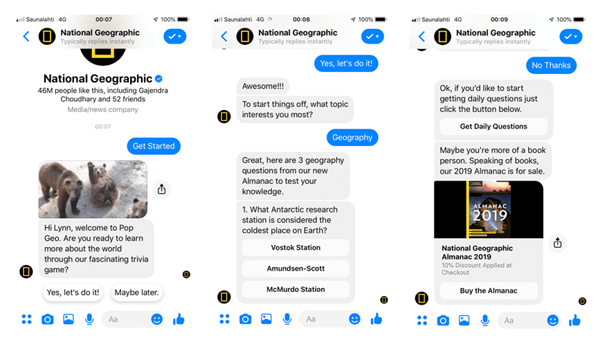 National Geographic chatbot entertains visitors with an educational trivia game. Very engaging and remarkable!
National Geographic chatbot entertains visitors with an educational trivia game. Very engaging and remarkable!
Any company looking to build relationships with their customers can use chatbots to create an attractive, fun quiz to promote a series of products/services by giving a discount; or, even better, giving it away for free to a selected group of people.
16. Chatbots Introduce New Products/Services
To maximize sales, every business should try to provide customers with relevant product recommendations whenever possible. Open the website of any big multinational company such as Amazon, Ikea, or AliExpress and you’ll see many different sections showing visitors relevant product recommendations.
The reason companies do this is that the more relevant products that get recommended, the more sales a company makes. Plus, for the would-be-customer, it reduces conflict and the customer doesn’t have to think a lot about what to buy.
For this reason, there are many tools and strategies a company can use to generate product recommendations. One of those tools that do an excellent job of this is chatbots.
With chatbots, companies can introduce their products and services by providing a tailored experience to visitors using chatbots. The chatbots can ask what types of products the visitor prefers and give highly relevant options. In this way, the company can make more sales.
MVMT, a fashion-brand that develops watches and sunglasses and especially targets millennials, uses this strategy to great effect with their chatbot use case.
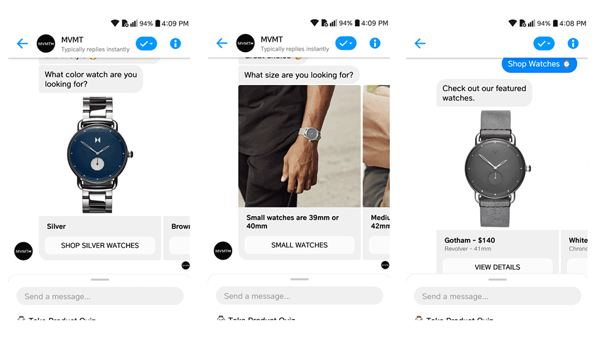 This chatbot helps customers to find the right watch fast and promotes the new models at the same time.
This chatbot helps customers to find the right watch fast and promotes the new models at the same time.
With a series of questions and clickable answers (combined with beautiful product pictures), the MVMT chatbot lets visitors know exactly what options they can choose. By the time they reach the end of the quiz, visitors see a list of recommendations that interests them the most. In this way, MVMT gets sales from its chatbot.
17. Equip Chatbots With Upsell, Downsell and Cross-sell Tactics
When a customer buys a product from a business/company, one should not consider it the end of a transaction - but rather the start of a relationship. That’s because, according to HBR, more than 70% of customers are interested in hearing from retailers after they make a purchase, especially if they provide personalized content.
But how can a business provide choices to the customer at the right time?
On websites, discounts may or may not have been listed. On emails, there is no guarantee that customers will even open a company’s promo let alone click on it. And what about pop-ups? Well, customers don’t like filling forms very much.
The ideal strategy instead is to show customers an upsell/down-sell offer when they are the most engaged with a company’s products and services.
Chatbots help do exactly that.
While a customer is learning about a company's products/services through their chatbot, this is when the chatbot can show the person an attractive upsell/down-sell offer. Since the person is already engaged with the company’s products, they will seriously consider (and probably accept) the offer being shown by the chatbot, thus increasing sales.
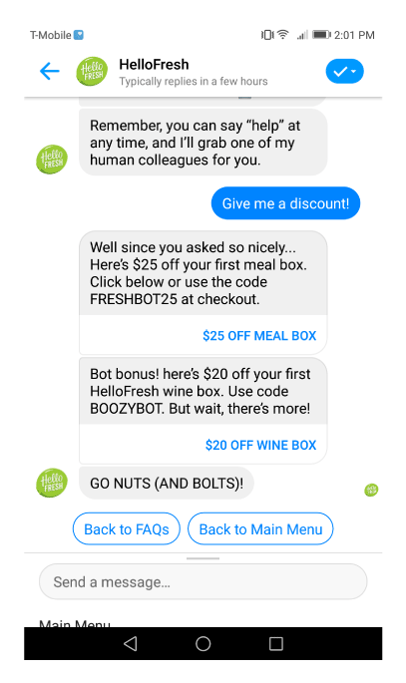 This chatbot is not only helping customers to place an order, but also provides exclusive discounts for a smooth buying process. Image credit
This chatbot is not only helping customers to place an order, but also provides exclusive discounts for a smooth buying process. Image credit
HelloFresh, a meal-kit delivery service, is an example of a chatbot use case for this very purpose. They offer discounts to people looking through their meal boxes. Plus, by offering chatbot-exclusive discount codes, i.e., FRESHBOT25, they can track exactly how many customers they are getting through their chatbot.
Any business that provides a range of products and services at different price-points can use this chatbot use case to offer upsells, downsells and cross-sells, to increase their chances of getting a sale from a customer.
18. Chatbots Can Execute Drip Campaigns
Email marketing is an effective customer acquisition channel, one which many businesses rely on to get new customers. This is because, with emails, you can create multiple drip campaigns for audiences with different needs, requirements, and interests.
However, getting a visitor on the company’s website interested in a company’s email series the business/company is providing can be a real challenge because it doesn’t matter how effective the email campaigns are. Unless website visitors are subscribing to them, email campaigns are of no use.
Businesses can use another effective customer acquisition tool and combine it with their email marketing efforts to develop a more powerful lead generation channel. That customer acquisition tool is a chatbot.
By deploying a chatbot on your website and its apps, a business can try engaging its customers in a conversation by asking them multiple questions. Because of the conversational nature of the chatbot, many visitors will participate, if only out of curiosity. In the end, the chatbot can request, and store the email of the participating visitor.
Based on the answers a visitor gives, the company can add their email address to the right kind of marketing campaigns. Only with a chatbot can such advanced segmenting be made possible right from the very start.
A company using this chatbot use case to great effect is Reply.io- a cold email automation tool.
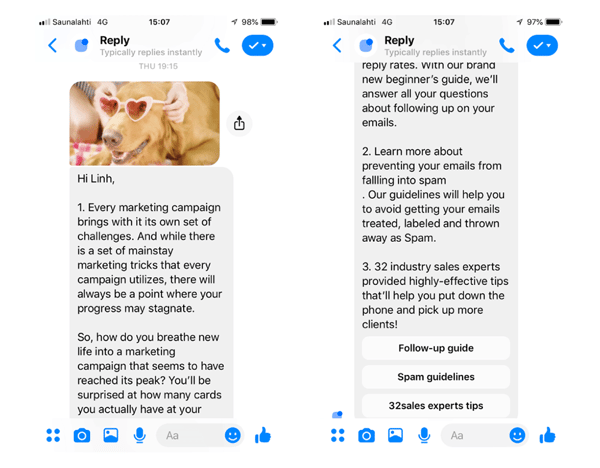 This chatbot sends email-like messages on different messaging platforms.
This chatbot sends email-like messages on different messaging platforms.
Their chatbot poses thoughtful discussions to its users on behalf of the company and tries to get answers to questions before even asking for their email so that Reply.io may be able to send more relevant emails with relevant content to the leads.
Besides emails, companies can use chatbots on messaging platforms like WhatsApp, Telegram, and Facebook Messenger to send drip campaigns to users. This gives their marketing departments two main benefits:
- They can access their customers on a preferred communication platform, i.e., text messenger.
- They can send drip campaign messages to users and measure their users' responses just like in email.
In this way, chatbots can properly nurture their audience for as long as they want.
19. Chatbots Improve Your Product Onboarding
For software companies, teaching new customers to know how to use software or tools is very important to converting new (or trial) customers to loyal customers. That’s because, unless customers understand how to use the product/service, they won’t use it. And if they don’t use the product/service they bought from the companies, they will churn and go to other competitors. This can result in the company losing customers faster than they acquire them.
The only way to stop this from happening is by creating a crystal clear onboarding experience and guiding customers through the service right from the start. By giving customers an idea of what the service they are buying does and how it operates, businesses can significantly increase the chances of their customers using their products.
Chatbots can help create this onboarding process by becoming a tour guide for the company’s products and services by showing customers how a product operates or a service works before they even buy it.
That’s because a chatbot can not only use text but also bring images, videos, and GIFs into conversations, enabling it to show customers how a company’s product/service works.
Plum, a company which creates an AI-equipped, money-saving software, uses a chatbot to teach incoming users how their product works. Their chatbot starts by introducing their software and giving social proof and then asks users whether they’d like to learn more. If they choose ‘yes’, the chatbot starts explaining how the Plum app works.
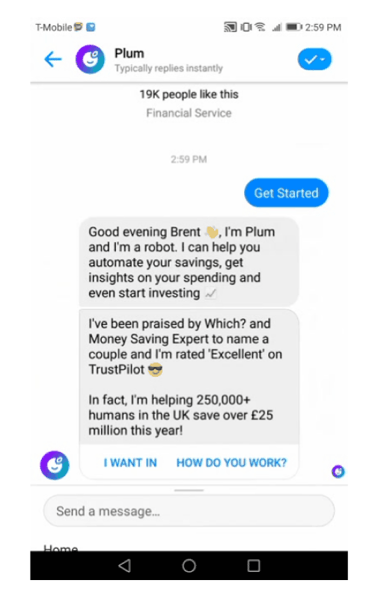 A chatbot helps new customers start using the product and saves your employee's time.
A chatbot helps new customers start using the product and saves your employee's time.
And like Plum, any business or company looking to explain, onboard, and give a product tour can use this chatbot use case to guide their customers through their product/service right within their website or mobile app.
Chatbot Use Cases in Sales
20. Chatbots Demo And Show Requested Products
While businesses should try giving a variety of choices to their customers, they should do so cautiously. That’s because if companies go overboard giving customers too many choices, customers may not go through with their purchases. That’s because research has shown that too many choices can confuse and frustrate customers, making them doubtful about their purchases rather than confident.
A better solution instead would be to categorize products into specific and limited categories, then gently guide users through the product catalog and ask them what products they wish to see.
This makes it easier for the customer to digest and understand the sheer variety of products available to them.
To showcase products in a step-by-step manner, a company can use a chatbot, which has all the tools necessary to implement this feature. A chatbot can provide customers with multiple-choice questions, with each question having its own image, text and/or video. By using these features, chatbots can ask customers to choose a product category, which customers can select in one click.
This process can be repeated multiple times in the chatbot until the customer lands on a product category that’s truly refined and only showing those products they actually want to see.
Nordstrom uses this exact chatbot use case in its KiK chatbot. Because they have a lot of products and a lot of people buying their products, the step-by-step product showcase system in their chatbot gives them the ability to showcase the right products to the right audience.
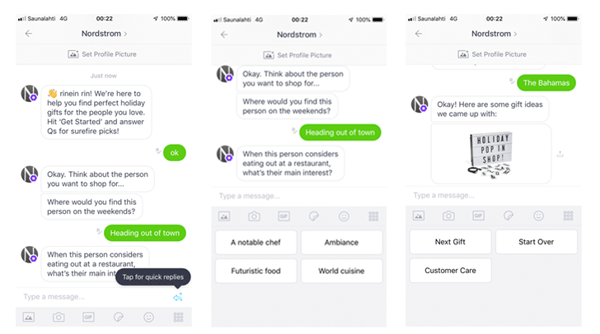 A great example of a chatbot providing product recommendations and demos.
A great example of a chatbot providing product recommendations and demos.
Other companies similar to Nordstrom that have multiple product categories and diverse audiences can also use this chatbot use case to provide an immersive, visual product demo experience. Businesses can also use chatbots like this to provide product recommendations to people looking for a holiday gift, anniversary present, etc.
21. Chatbots Become Personal Shopping Assistants
Today’s customers are smart shoppers and, therefore, like to be educated about the products they are buying. They want to know what varieties, sizes, and colors are in stock - plus any other information they can get their hands on. Also, customers don’t want to wait around for this information. They expect fast responses otherwise they will move on to the next vendor.
For businesses, implementing such a service requires a huge investment in necessary hires, infrastructure, and technology. In addition to monetary investments, companies must take the time to develop and streamline these new services within their sales departments.
Companies can reduce costs and onboarding time dramatically by building such an infrastructure with the help of a chatbot.
Thanks to the chatbot’s AI technology and ability to contextually understand and analyze keywords in a customer request or question, businesses can provide customers with a sales agent, i.e., a personal shopper that’s available 24/7, ready to bring up product specifications and demos within seconds.
This isn’t just theory, but an actual chatbot use case being applied by H&M, who with the help of their chatbot, makes it easier for customers to find products with exactly the right fit and size. Their chatbot regularly provides style guides, choices and product pricing, helping H&M improve customers shopping experience.
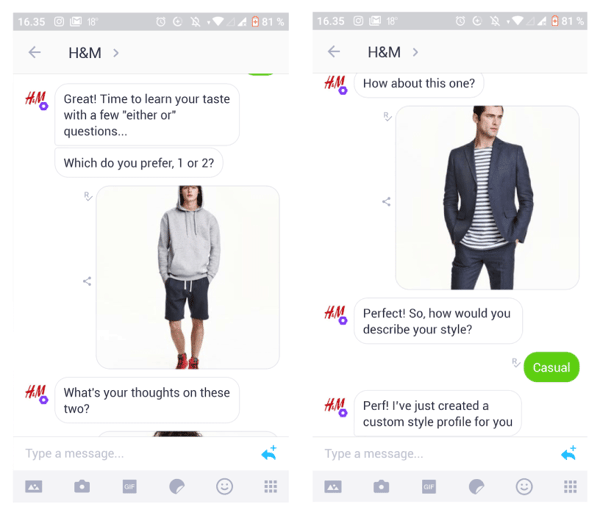 A chatbot can deliver remarkable customer experience by becoming a personal assistant.
A chatbot can deliver remarkable customer experience by becoming a personal assistant.
Any company wishing to provide customers with their own digital assistant can use this chatbot use case to provide customers with in-depth, fast and efficient knowledge regarding the products they wish to buy. This method can definitely help them increase sales and retain more customers online.
22. Chatbots Serve As Sales Agents
Every business dreams to be operational 24/7 and serve customers even after the shop has closed and the business day has come to an end. But for many medium-to-small businesses, building such an enterprise, where customers are served day-and-night, is not possible. After all, staffing your sales department runs 24/7 is no easy task.
But this is not the only option. While less powerful than an actual sales agent, a chatbot can still do a fantastic job of closing sales by dealing with customers around the world. With its easy conversational system - and the ability to converse using rich content like pictures, GIFs and videos, a chatbot can do a great job of showing products to customers and making sales.
And that’s not all.
Even if a customer doesn’t buy a product, a chatbot can still try to get their email address and try to schedule a demo. Or it can even just get their lead information. Because of this, a company or business can provide a very competent sales agent that can bring them sales 24/7 at the fraction of the cost it would take to build a full-fledged sales team.
One company using chatbots for this very exact scenario is Snaptravel. Using an AI chatbot, they created an awesome automated sales agent that can book flights and hotels for customers based on budget and schedule. If there is an issue the chatbot can’t handle, it will quickly bring a live sales agent abroad. Plus, it will also capture the lead information of customers by giving them the ability to get instant alerts for promos and discounts via Whatsapp, Facebook messenger, or text.
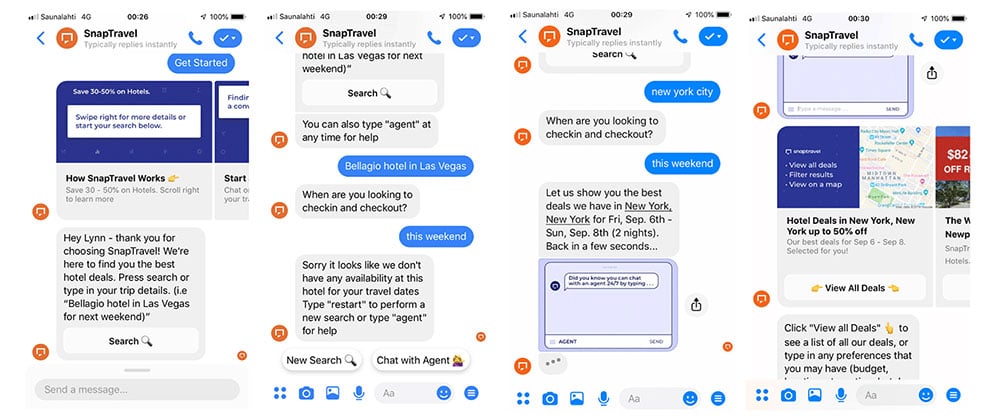
A chatbot can deliver remarkable customer experience by becoming a personal assistant.
23. Chatbots Provide Quotes and Estimates
Before buying products/services, today’s customers like to do research. And during their research quest, they often try to contact a business/service to learn more about a product’s price, i.e., a quote, in order to make a decision. - This plays a big influence in their purchasing journey.
For your sales agents, answering such a question could take a lot of time and effort.
A chatbot can do this job instead, freeing sales agents to work on more complex issues for higher priority customers. After all, sales agents will take time to find the price of each product and quote it to customers. But chatbots, since they can be directly connected to a database, can identify keywords in a customer’s price request, then quickly bring up prices for the right products.
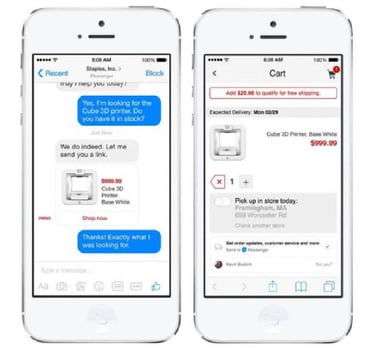
Staples uses chatbots for this very task. It shows customers whether it has a product in stock - and then lists its price. Notice how the chatbot also shows the product images and has a ‘shop now’ button underneath so customers can quickly visit the page and buy the product whose price the chatbot quoted.
Other companies who deal with many different products (or even just a few) can apply this chatbot use case to quickly answer customer requests for price quotes.
24. Chatbots Can Connect Sales, Customer Support and More
Most companies using chatbot do so for one purpose only. Either it’s for making sales, generating leads, or providing support. While chatbots certainly are effective at each individual task they are given, chatbots built this way won’t realize their full potential.
Moreover, for business, when it comes to tools and technologies, the best kinds are the ones that can integrate and perform different roles and activities respectively. Such tools execute processes much more smoothly and bring better results.
And chatbots are exactly that kind of tool.
Companies can set up and equip their chatbots with the capabilities to not just perform customer service or sales services, or lead generation - but all three. And that’s not all. Over time, as companies see how customers interact with their chatbots, additional services can be built in the chatbots as well.
As a result, companies and businesses can start utilizing chatbot use cases to their full potential, thus reducing their operational costs and increasing their sales. All this, in the end, will show a significant positive result in the net revenues and profits of the company.
PandaDoc is an example of a chatbot use case exploited to its full potential.
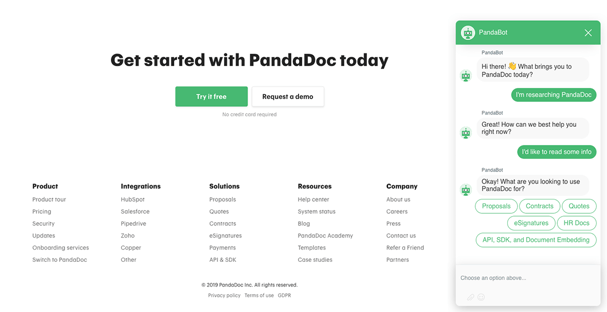
This chatbot has multiply functions and conversation scenarios.
Customers can ask the Pandabot, i.e., PandaDoc’s chatbot multiple questions - and choose from a multitude of services. It can give a small demo about the product, give sales information regarding pricing and provide support to existing users. If it is unable to answer a complex question, the Pandabot can connect a live agent if available right in the same chatbot window.
In this way, a business with more than one department for providing services to customers can use chatbots to extend their services beyond their working hours by putting a chatbot online on their website or mobile application.
25. Chatbots Are The Best Assistants To Your Sales Team
So far, the chatbot use cases discussed in this article are customer-centric, i.e., focused on helping customers and thereby, indirectly reducing the workload of the relevant business.
Therefore, for this last chatbot use case, we’re going to go out of the box and recommend an internal use-case for chatbots instead.
That’s because it isn’t just customers who need help solving complex problems. An organization’s employees, i.e., tech support teams, customer service agents, and salespeople, also need help figuring out answers to complex problems and questions as well (usually from customers themselves).
In this chatbot use case, a chatbot can become a valuable assistant for teams within a company. Chatbots can be used to find answers to commonly asked questions, search a database for current product stats, or to determine answers to other queries or solutions.
This is because chatbots can be connected to a company’s database, and, using AI, can quickly find the information required by the sales agent regarding the company’s product or service.
This will enable sales agents to respond faster and convert leads more quickly. We helped one of our clients implement the chatbot use case helping the sales agents in their sales team. After a few months of running, the efficiency and performance of the sales team increased tremendously.
Conclusion
You have seen 25 innovative chatbot use cases that can help your business grow. And of course, the above list of use-cases is not exhaustive. Chatbots can certainly do much more. As time passes, more and more businesses will be taking advantage of chatbots and its AI technologies.
Every single year, the interaction between customers and chatbots keeps increasing. For example, it is predicted that chatbots will handle up to 85% of all customer interaction requests by 2020, which would significantly cut costs and free up employees' time for more demanding tasks.
Plus, let’s not forget that chatbots give companies the ability to provide 24/7 instant services to customers in a human-like manner. Such a fast and smooth customer service help companies build brand loyalty and bring new clients to the business with lower advertising costs. Just take a look at this or this case study on how chatbots help companies increase customer satisfaction score and provide a superior service.
Are you ready to build your first customer service chatbot?
Mikko Rindell
Marketing Director
Similar articles

Chatbot Case Studies for Media and Entertainment Companies
How can media and entertainment companies keep up with customers? Learn how chatbots help service teams stay on track and serve customers better.

4 Things You Need to Know When Considering Chatbots
Ersin walks through the surprising opportunities potential chatbot customers miss in their chatbot project planning.

Must-Have AI Chatbot Features for Better Customer Experience
Are you considering an AI chatbot? This guide helps you ask the right questions to chatbot vendors about chatbot features when you compare options.


